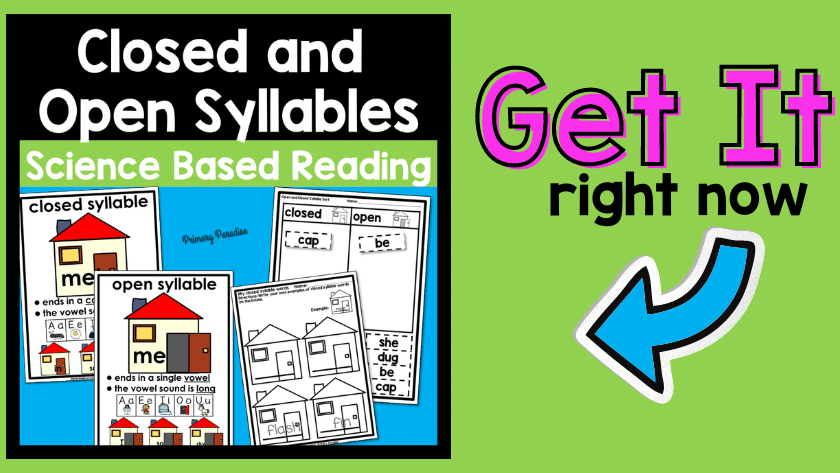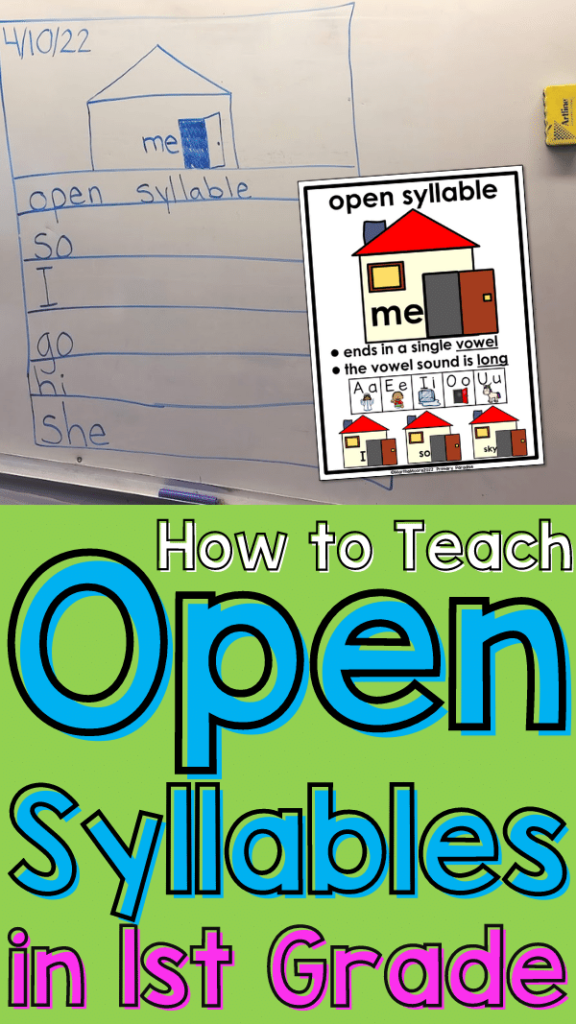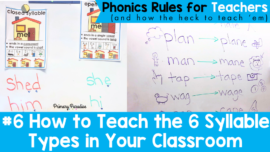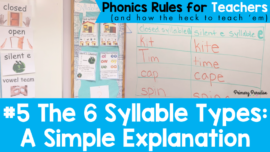Teaching open syllables to your students can help them decode and write a large number of words. Single syllable open syllable words are some of the most common words used in the English language which means they are very important to teach young students. Here is how you can teach open syllables to your first grade, second grade, or kindergarten students.
What do students need to know before you teach open syllables?
If you’d like a complete breakdown of syllable types, you can find that in this post here.
Strong Understanding of Short Vowel Sounds and Consonants
Before you teach open syllables, your students need a solid understanding of short vowel sounds and consonant sounds. Since long vowels “say their name” or make the same sound as their name, it’s wise to teach the short vowel sounds first since they are the more common form of each vowel. It’s also important for students to understand the difference between vowels and consonants.
Understand Closed Syllables

Before we begin to learn about open syllables, it’s important that you first teach closed syllables. You can read how to teach closed syllables here. Closed syllables make up about 50% of the syllables in the English language and also use the short vowel sounds which means you should teach them first. Once students have a solid understanding of closed syllables though, it’s the perfect time to introduce open syllables. Once students know both open and closed syllables, they will have the tools to read about 75% of all syllables in the English language!
Introduce to the Idea of Long Vowel Sounds
Before diving right into open syllables, I like to introduce the idea of long vowel sounds to prepare my students to understand open syllables. We learn that vowels all have a short vowel sound and a long vowel sound. I tell my students that long vowels say their name since this is an easy way to remember the long vowel sounds. We will orally listen to, say, and segment words with long vowel sounds. In this stage, it’s not important if it’s an open syllable or a vowel team as it’s an oral activity.
Why not memorize?
Before I get into how I teach open syllables, I want to say one more thing about how I don’t teach open syllables or any letter sound combination. It might be tempting to just have students memorize lists of words. After all, that’s probably what you did when you were in school. However, the science shows us that this is not an effective or brain friendly method. If I memorize the words so and me, I know how to read two words. However, if I learn that open syllable words end in a single vowel and make a long vowel sound, with practice, I will be able to read any words that fit this predictable pattern. So, the moral is that spending the time to teach syllable types can and will have a big pay off in the end!
How to Teach Open Syllables in First Grade
I teach open syllables in a very similar way to how I teach closed syllables because consistency and repetition pays off! First we review closed syllables. I’ll write words on the board that can easily be turned into open syllables such as wed, shed, hit, and got. We review that closed syllables have a single vowel and end in a consonant or series of consonants. Then I ask students to think about the word closed syllable. I ask what might another syllable type be? They normally come up with open on their own.
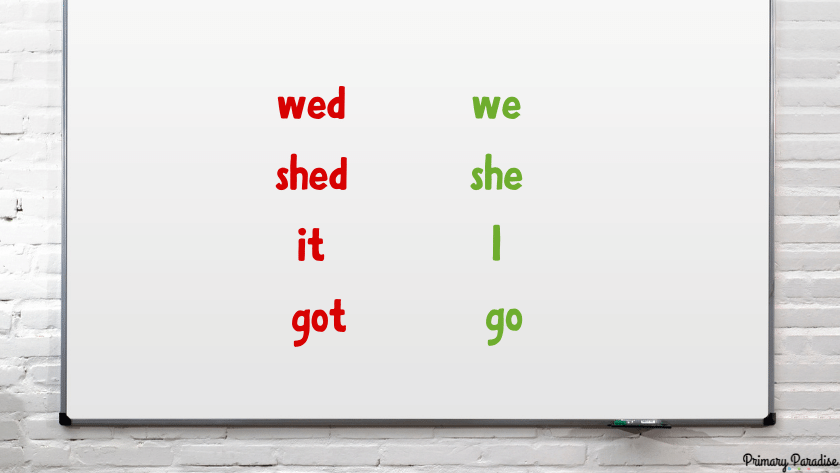
Next to the closed syllable examples, I write the word again without the ending consonant: we next to wed, she next to shed, hi next to hit. We talk about how the syllable ends in a single vowel. At least a one or two students typically recognizes a word or two, and I ask them to read it out loud.
We listen to the difference between the words- example wed and we. I ask them to tell me what sound each vowel is making. They already know that e is making the short /e/ sound. They then notice that the e in we is saying it’s own name. I remind them that this is the long e sound.
We take a look at the word again, and I remind them that this is called an open syllable. Why might it be called an open syllable? We realize it’s because it ends in a vowel which means there’s no consonant closing it in. So, the vowel is long.
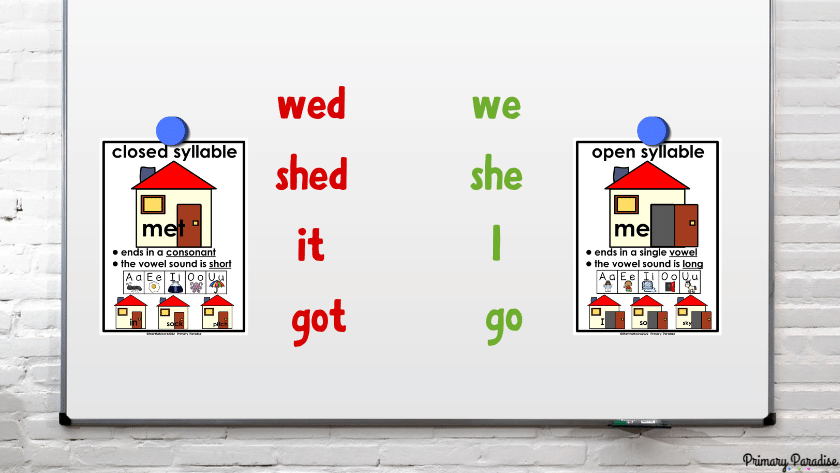
I show them the open syllable poster with a house with an open door. Just like with closed syllables, I use a hand motion to help them recall open syllables. We put our hands in front of our faces, and then move them to the sides and say “open syllable ends in a single vowel and makes a long vowel sound”.
From here we’ll practice reading open syllable words together. I start with single syllable open syllable words. There are so many important one syllable words in this pattern that make up some of the most frequently used words! These words, according to Oxford Dictionary, rank in the top 100 used words: be, I, he, by, we, she, my, go, so, me, no. If we think about most decodable texts and early reading material, children need to know at least some of these words to be able to read them. It’s very hard to form sentences without using any of these words. So, teaching open syllables is time well spent!
Again, if we teach this spelling pattern, students can read many open syllable words. If we only taught them to memorize me, go, and I, then they can only read me, go, and I.

After we’ve read some words together, we will complete a journal entry to record our learning. I find this very helpful to have the students create the visual in the moment. It also allows them to go back and refer to it later on. I normally do the journal the next day after we’ve reviewed open syllables and read some open syllable words together. It’s better to spread the learning over a few days to ensure that it sticks.
After completing their journal, our work with open and closed syllables isn’t done. We will continue to work with words with both syllable types in many ways. We will map new words and determine if they are open or closed syllables. We’ll also talk about variations such as how the is an open syllable word, but the e is not pronounced with a long e sound due to lazy pronunciation over time. I’ll even explain the schwa sound a bit (but that’s another topic for another blog post).
As we’re writing in our journals or reading together, we’ll point out open syllable words or closed syllable words. Using these skills in other contexts will help to solidify the understanding.
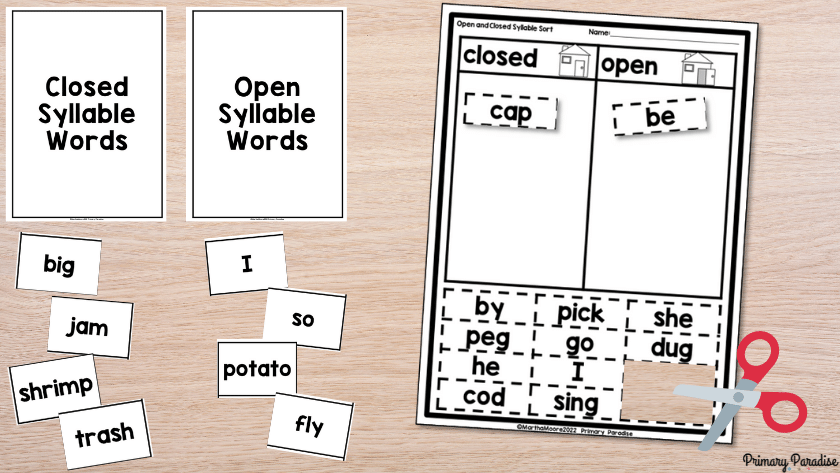
I also really enjoy having students sort open and closed syllables. This is because it helps their brains categorize and sort words as well. We will do this both together and also students practice this independently.
The bottom line is that my student’s reading and writing improves immediately and for the long term as they learn and understand open syllables.
